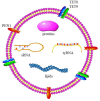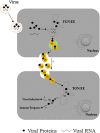Extracellular vesicles: Their functions in plant-pathogen interactions
- PMID: 34873812
- PMCID: PMC9104264
- DOI: 10.1111/mpp.13170
Extracellular vesicles: Their functions in plant-pathogen interactions
Abstract
Extracellular vesicles (EVs) are rounded vesicles enclosed by a lipid bilayer membrane, released by eukaryotic cells and by bacteria. They carry various types of bioactive substances, including nucleic acids, proteins, and lipids. Depending on their cargo, EVs have a variety of well-studied functions in mammalian systems, including cell-to-cell communication, cancer progression, and pathogenesis. In contrast, EVs in plant cells (which have rigid walls) have received very little research attention for many decades. Increasing evidence during the past decade indicates that both plant cells and plant pathogens are able to produce and secrete EVs, and that such EVs play key roles in plant-pathogen interactions. Plant EVs contains small RNAs (sRNAs) and defence-related proteins, and may be taken up by pathogenic fungi, resulting in reduced virulence. On the other hand, EVs released by gram-negative bacteria contain a wide variety of effectors and small molecules capable of activating plant immune responses via pattern-recognition receptor- and BRI1-ASSOCIATED RECEPTOR KINASE- and SUPPRESSOR OF BIR1-mediated signalling pathways, and salicylic acid-dependent and -independent processes. The roles of EVs in plant-pathogen interactions are summarized in this review, with emphasis on important molecules (sRNAs, proteins) present in plant EVs.
Keywords: effector-triggered immunity; exosome; extracellular vesicles; pathogen-associated molecular patterns-triggered immunity; plant; plant disease; systemic acquired resistance.
© 2021 The Authors. Molecular Plant Pathology published by British Society for Plant Pathology and John Wiley & Sons Ltd.
Figures




References
-
- An, Q. , Ehlers, K. , Kogel, K.H. , van Bel, A.J. & Hückelhoven, R. (2006) Multivesicular compartments proliferate in susceptible and resistant MLA12‐barley leaves in response to infection by the biotrophic powdery mildew fungus. New Phytologist, 172, 563–576. - PubMed
-
- Bahar, O. , Mordukhovich, G. , Luu, D.D. , Schwessinger, B. , Daudi, A. , Jehle, A.K. et al. (2016) Bacterial outer membrane vesicles induce plant immune responses. Molecular Plant‐Microbe Interaction, 29, 374–384. - PubMed
Publication types
MeSH terms
LinkOut - more resources
Full Text Sources
Research Materials
Miscellaneous

